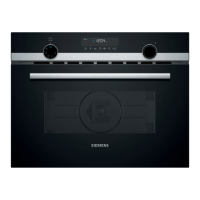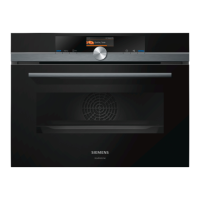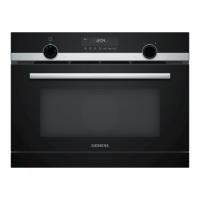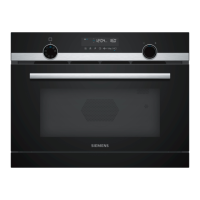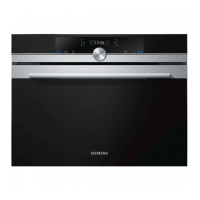en Tested for you in our cooking studio
32
Poultry
Notes
■ Place whole chickens and chicken breasts breast-
side down. Turn after Z of the cooking time.
■ Place poulard breast-side down. Turn after
30 minutes and set the microwave power to
180 watts.
■ Place half chickens and chicken portions skin-side
up. Do not turn.
■ Turn the duck and goose breast skin-side up. Do not
turn.
■ Turn goose thighs halfway through the cooking time.
Prick the skin.
■ Place turkey breast and thighs skin-side down. Turn
after Z of the cooking time.
Fish
Notes
■ For grilling, place the whole fish, e.g. trout, onto the
middle of the higher wire rack.
■ Grease the wire rack with oil beforehand.
Tips for roasting and grilling
Poultry Accessories Type of
heating
Temperature in
°C, grill setting
Microwave power in
watts
Cooking time
in minutes
Chicken, whole, approx. 1.2 kg Ovenware with lid 4 220-230 360 35-45
Poulard, whole, approx. 1.6 kg Ovenware with lid 4 220-230 360
180
30
20-30
Chicken, halves, 500 g each Ovenware without lid 4 180-200 360 30-35
Chicken portions, approx. 800 g Ovenware without lid 3 210-230 360 20-30
Chicken breast with skin and bones,
2 pieces, approx. 350-450 g
Ovenware without lid 4 190-210 180 30-40
Duck breast with skin, 2 pieces, 300-400 g
each
Ovenware without lid š 3 90 20-30
Goose breast, 2 pieces, 500 g each Ovenware without lid 4 210-230 90 25-30
Goose legs, 4pieces, approx. 1.5 kg Ovenware without lid 3 210-230 180 30-40
Turkey breast, approx. 1 kg Ovenware with lid 3 200-220 - 90-100
Turkey drumsticks, approx. 1.3 kg Ovenware with lid 4 200-220 180 50-60
Fish Accessories Type of
heating
Temperature °C Cooking time in min-
utes
Fish steak, e.g. salmon, 3 cm thick, grilled Higher wire rack š 3 20-25
Whole fish, 23 pieces, 300 g each, grilled Higher wire rack š 3 20-30
The table does not contain information for the weight
of the joint.
For small roasts, select a higher temperature and a shorter cooking time. For larger roasts,
select a lower temperature and a longer cooking time.
How to tell when the roast is ready. Use a meat thermometer (available from specialist shops) or carry out a “spoon test”. Press
down on the roast with a spoon. If it feels firm, it is ready. If the spoon can be pressed in, it
needs to be cooked for a little longer.
The roast looks good but the juices are burnt. Next time, use a smaller roasting dish or add more liquid.
The roast looks good but the juices are too clear and
watery.
Next time, use a larger roasting dish and add less liquid.
The roast is not well-done enough. Carve the roast. Prepare the gravy in the roasting dish and place the slices of roast meat in the
gravy. Finish cooking the meat using the microwave only.

